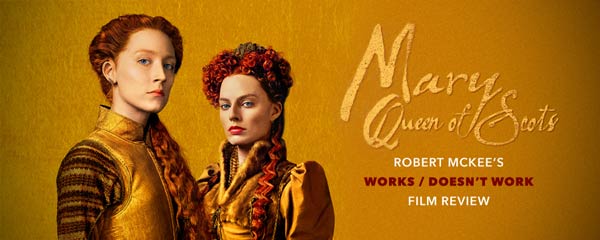
Robert McKee’s “Works/Doesn’t Work” Review
MARY QUEEN OF SCOTS
Written by Beau Willimon & John Guy
It Doesn’t Work. (Spoiler Alert!)
Banal Storytelling
Screenplays that split along two storylines put alternating plots and protagonists on a collision course and maintain pace by crosscutting.
Examples:
- CRIMES AND MISDEMEANORS (1989) Woody Allen and Martin Landau
- SLIDING DOORS (1998) Gwyneth Paltrow in a dual role
- HEAT (1995) Al Pacino and Robert De Niro
- BROKEBACK MOUNTAIN (2005) Heath Ledger and Jake Gyllenhaal
- THE LIVES OF OTHERS (2006) Ulrich Muhe and Sebastian Koch
- THE DEPARTED (2006) Matt Damon and Leonardo DiCaprio
In some cases, the two stories relate thematically, so the editing crosscuts an idea in a point/counterpoint rhythm. CRIMES AND MISDEMEANORS plays the idea of crime as comedy versus drama; SLIDING DOORS plays knowing the truth against not knowing the truth.
In most cases, however, the two stories relate causally: what happens in storyline A causes a reaction in storyline B that becomes an action in B that triggers a reaction in A that becomes an action in A that causes… and so the crosscutting goes, action/reaction, cause/effect, building pace to climax.
Unfortunately, MARY QUEEN OF SCOTS uses little of either technique. Instead, the enmity between Mary and Elizabeth becomes a kind of legal argument that drags on for 40 years. Scenes are thinly disguised prosecution v. defense debates over whose queenship is legitimate.
On-the-Nose Dialogue
As you might expect, this story strategy constipates the dialogue with lumps of on-the-nose exposition. When two characters tell each other something they both already know, or should already know, an alarm should clang in the screenwriter’s head and keep clanging until the scene is reinvented.
On-the-nose dialogue is not only phony but devoid of subtext and subtext is the stuff and substance of acting. Hats off to the brave actors who spit out those words.